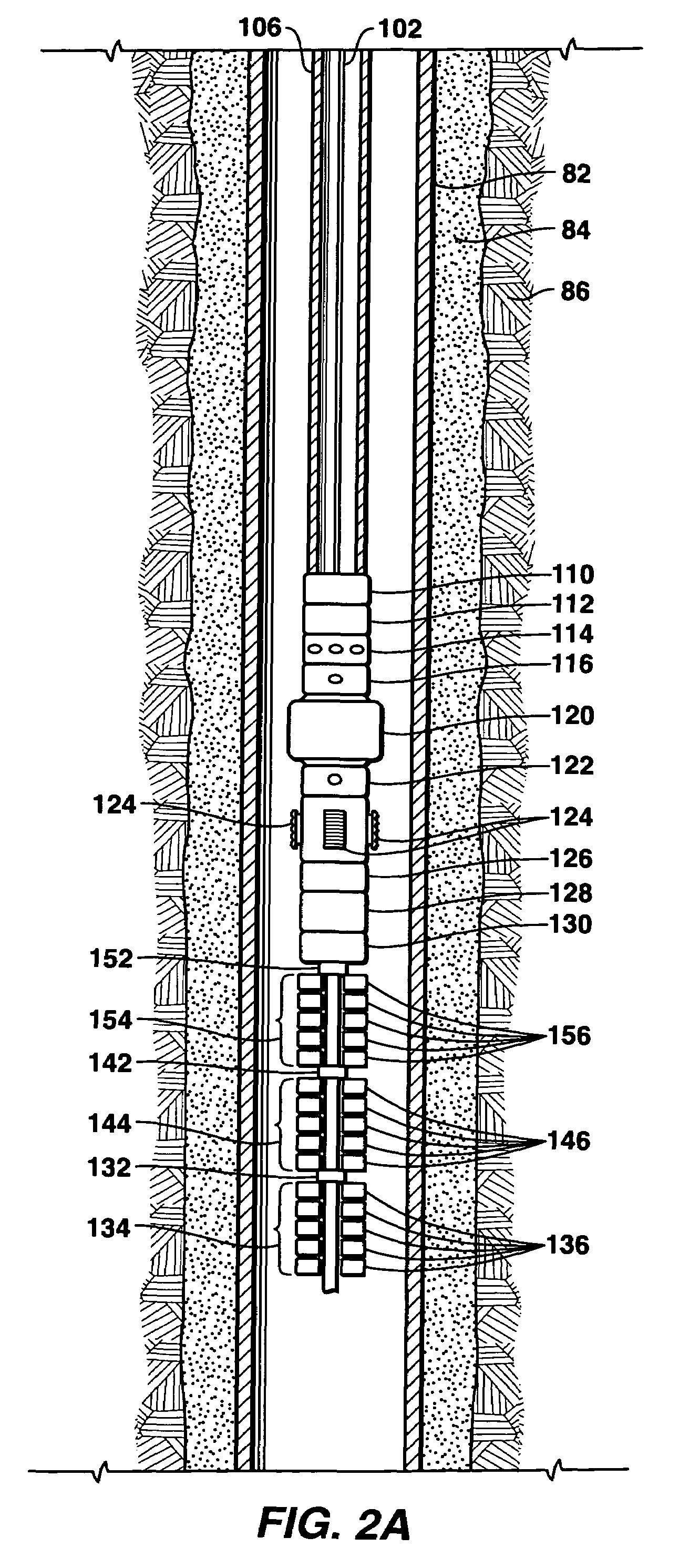Method and apparatus for stimulation of multiple formation intervals
a technology of multiple formation intervals and apparatus, which is applied in the direction of drilling casings, wellbore/well accessories, pipes, etc., can solve the problems of high treatment cost, high risk of complications, and bridge plugs that cannot be drilled out at great expens
- Summary
- Abstract
- Description
- Claims
- Application Information
AI Technical Summary
Problems solved by technology
Method used
Image
Examples
second embodiment
[0107]FIG. 5 illustrates the invention where coiled tubing is used as the deployment means and excess friction is not of concern and either proppant is not pumped during the job or use of proppant is not of concern. FIG. 5 shows that coiled tubing 106 is used to suspend the BHA and BHA components. In this embodiment, the individual zones are treated in sequential order from shallower wellbore locations to deeper wellbore locations. In this embodiment, as shown in FIG. 5, circulation port 114 is now placed below the inflatable, re-settable packer 120 such that treatment fluid may be pumped down the interior of coiled tubing 106, exit the circulation port 114, and be positively forced to enter the targeted perforations. As an illustration of the operations, FIG. 5 shows that the inflatable, re-settable packer 120 has been actuated and set below perforations 241 that are associated with a previous zone hydraulic fracture 242. The inflatable, re-settable packer 120 provides hydraulic is...
third embodiment
[0108]FIG. 6 illustrates the invention where coiled tubing is used as the deployment means and excess friction is not of concern and either proppant is not pumped during the job or use of proppant is not of concern. FIG. 6 shows that coiled tubing 106 is used to suspend the BHA and BHA components. In this embodiment, the individual zones may be treated in any order. In this embodiment, as shown in FIG. 6, a straddle-packer inflatable sealing mechanism 125 is used as the re-settable sealing mechanism and the circulation port 114 is now placed between the upper inflatable sealing element 121 and the lower inflatable sealing element 123. When the upper inflatable sealing element 121 and the lower inflatable sealing element 123 are actuated, treatment fluid may be pumped down the interior of coiled tubing 106 to exit the circulation port 114, and then be positively forced to enter the targeted perforations. As an illustration of the operations, FIG. 6 shows that the upper inflatable sea...
fourth embodiment
[0109]FIG. 7 illustrates the invention where a wireline 102 is used as the deployment means to suspend the BHA and BHA components. In this embodiment, the individual zones are treated in sequential order from deeper wellbore locations to shallower wellbore locations. In this embodiment, as shown in FIG. 7, treatment fluid may be pumped down the annulus between the wireline 102 and production casing wall 82 and be positively forced to enter the targeted perforations. In this embodiment, the inflatable re-settable packer 120 also contains an internal electrical pump system 117, powered by electrical energy transmitted downhole via the wireline, to inflate or deflate the inflatable, re-settable packer 120 using wellbore fluid. FIG. 7 shows that the inflatable, re-settable packer 120 has been actuated and set below the perforations 241 that are associated with the next zone to be fractured. The inflatable, re-settable packer 120 provides hydraulic isolation such that when treatment flui...
PUM
 Login to View More
Login to View More Abstract
Description
Claims
Application Information
 Login to View More
Login to View More - R&D
- Intellectual Property
- Life Sciences
- Materials
- Tech Scout
- Unparalleled Data Quality
- Higher Quality Content
- 60% Fewer Hallucinations
Browse by: Latest US Patents, China's latest patents, Technical Efficacy Thesaurus, Application Domain, Technology Topic, Popular Technical Reports.
© 2025 PatSnap. All rights reserved.Legal|Privacy policy|Modern Slavery Act Transparency Statement|Sitemap|About US| Contact US: help@patsnap.com



